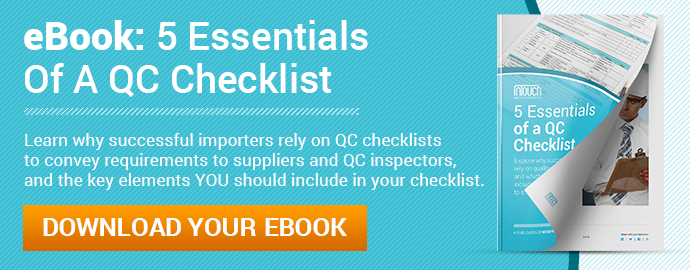Best in Manufacturing – October 14, 2018
Each Sunday, we publish a list of top articles and other content related to manufacturing in areas like quality control, product development, supply chain management, sourcing, auditing and law.
1. China’s new ecommerce law strengthens IP protections
According to Statista, 28.6 percent of all retail sales made in China this year were ecommerce sales. And by 2019, this number is predicted to grow another 10 percent.
But fake goods, minimal oversight and lackluster market regulation continue to negatively impact China’s ecommerce reputation.
To rebuild this reputation, Chinese lawmakers introduced a new ecommerce law that will take effect January 1, 2019. The law provides additional protection for consumers and brand owners on ecommerce platforms.
Law clarifies three types of ecommerce operators
Initially reviewed in December 2016 by the National People’s Congress Standing Committee, the law took more than two years to be approved.
Prior to the law there were no official classifications to differentiate ecommerce operators. Under the new law, operators are separated into three categories:
- Platform operators – People and organizations assisting in and providing a space for online sellers. For instance, Taobao is a platform operated by Alibaba.
- Operators on platforms – Merchants selling goods on ecommerce platforms.
- Online sellers – Sellers doing business through personal websites or other online channels, like social media platforms.
The categories clarify what types of operators fall under the new law’s jurisdiction. A significant inclusion being non-traditional shopping channels, such as social media and buying apps.
Platform operators are now held more accountable for IP violations
The new law makes an ambitious promise to "protect legal rights and interests of all parties". Article 22 of the legislation specifically highlights fair competition for all operators.
The law emphasizes platform operator obligations and responsibilities. By focusing on the most advantageous players in the ecommerce market, lawmakers hope to encourage operators to take responsibility for actions made on their platforms.
Under the new law, a platform operator is as liable as a merchant caught selling counterfeit goods on its platform. This fault previously lied solely on the merchants caught selling substandard goods.
And in a bid to strengthen IP protections, the new law requires ecommerce platforms to establish rules to protect IP rights and respond to violations in a timely manner.
The law also works on strengthening consumer protections. The legislation bans fake reviews written by paid agents and incentivized customers. And it requires merchants to clearly disclose clauses and bundles placed on sales.
As more consumers turn to online platforms, ecommerce laws will be essential in promoting a healthier Chinese ecommerce market.
For more information on the changes to China’s ecommerce laws, follow the link below.
China’s New e-Commerce Law: Businesses Should Ready for Stronger Compliance Norms – Lauren Eiko Fujino, China Briefing
2. Manufacturers moving production to Cambodia to avoid tariffs
Trade war news makes daily headlines. And if you manufacture in China, you’ve likely felt some concern over the rising tariffs.
The most recently announced tariffs on $200 billion worth of goods show an escalating trend with no signs of stopping. Maybe your product has eluded tariffs thus far, but will it be next?
Some companies are beginning to rethink their supply chains to avoid this uncertainty and rising production costs. Cambodia is one location drawing fleeing manufacturers.
Known for cheap, readily available labor, Cambodia is a logical jump from China.
But as companies rethink where to establish manufacturing operations, it may be hard to find a location that parallels China’s convenience and reliability.
Cambodia’s low labor costs tempt manufacturers
The trade war isn’t the only thing pushing companies out of China. Companies have been considering leaving China for years due to rising labor costs.
Spencer Fung of supply chain management company Li & Fung even says, “People are desperate to get out of China”.
Cambodia’s low labor costs are a major draw for many manufacturers looking to avoid the rising cost of Chinese labor. Labor costs in China have risen 64 percent since 2001. As of today, the minimum legal monthly wage in Cambodia remains below $170.
Cambodia’s manufacturing labor costs have risen about 178.7 percent since 2012. But annual factory worker wages in China are still about five times those in Cambodia.
Are lower labor costs a viable trade-off for decreased efficiency?
Cambodia places a lowly 94th on the World Economic Forum’s Global Competitiveness Index. China, on the other hand, comes in 27th place.
One of the reasons Cambodia ranks so low is because it lacks quality infrastructure.
Piet Holten manufactures microfiber cloths and bags in Phnom Penh.
Holten told the New York Times that manufacturing in Phnom Penh has its difficulties:
Where Cambodia sits now is where China was 25 years ago.
Infrastructure is an essential determinant of manufacturing lead times and plays a significant role in productivity. Infrastructure connects supply chains and allows goods and services to move across borders.
If you have a product with multiple inputs, easy access to those parts is essential to production success. Aaron Emigh, a manufacturer of smart home devices, needs more than 700 components for his products—almost all of which he sources in China. He thinks getting those components from China to Cambodia for assembly would be challenging:
Moving out of China is not purely a matter of cost, but of possibility.
Infrastructure is one of China’s manufacturing strengths—China has a vast network of dependable suppliers, workers, roads, rail lines and ports.
If you are considering moving part or all your manufacturing operations to Cambodia, it’s important to be realistic about the move. Labor may be cheap, but can the infrastructure support your production needs?
For more information about the realities of moving production out of China, follow the link below.
Trump’s Tariffs May Hurt, But Quitting China is Hard to Do – Alexandra Stevenson, New York Times
3. Blockchain offers unparalleled connectivity, but only if you trust it
According to a survey by IBM, one-third of C-level executives said they are considering adopting or are already using blockchain technology.
 Imagine the impact on production if you could track every single component of your supply chain, with continuous auditing and validation.
Imagine the impact on production if you could track every single component of your supply chain, with continuous auditing and validation.
This is the power blockchain possesses—a wealth of opportunity for those looking to increase supply chain speed and traceability.
But skeptics remain wary of blockchain’s roots in Bitcoin, a cryptocurrency shrouded in uncertainty. Concerns over the emerging technology range from regulatory uncertainty to the challenges of working with new collaborators.
Understanding blockchain’s potential could help you learn how to incorporate the emerging technology into your business operations.
What’s holding blockchain back?
In a study by PWC, the three greatest barriers to blockchain adoption were regulatory uncertainty, lack of trust among users and the ability to bring the network together.
Blockchain’s main purpose is to create transparency and traceability. But it can be difficult to have confidence in emerging technology—a precursor to trust.
Companies also struggle with understanding blockchain’s complexity. It’s abstract, technical and operates mostly behind-the-scenes. You may know about blockchain, but do you really understand it?
While early adopters scramble to catch up with the new technology, government bodies have yet to reach a consensus on regulation. And until regulations are defined, the business environment will likely remain unsettled.
Blockchain offers benefits difficult to replicate with other technology
If you can get past the trust issues, blockchain can be an extremely useful tool. And it’s on a clear path toward broad adoption.
According to a report by Markets and Markets, the global blockchain market size is expected to grow from $411.5 million in 2017 to $7.68 billion by 2022.
Blockchain’s foundation in tracking and auditing can help ensure integrity and authenticity of raw materials and finished products. It also allows retailers, producers and freight providers to collaborate in real time.
It can be difficult to trust anything new. But for many, the benefits of blockchain technology are too enticing to wait for greater industry adoption.
If you’re considering blockchain adoption, it’s okay to start small. Here we collected some tips for blockchain success:
- Pay attention to skeptics and evangelists – Learn from all sides of the debate so you can make an informed conclusion.
- Use teamwork to track development – Listen to industry leaders in both technical and business positions.
- Meet your trading partners – Understand your participants and try to work towards a consortium. The greatest benefits are reaped across trading ecosystems.
- Monitor regulatory risk – Track regulatory developments as the technology gains ground and falls under greater scrutiny.
The true power of blockchain rests within industry-wide adoption. When participants come together and create a shared platform, all contributors benefit.
As the reach of this technology increases, so will the opportunity for those who accept it.
Follow the link below for more information on the growth of blockchain.
In Blockchain We Trust ... Or Will Someday – Matthew Lieberman, Forbes
4. Changes to FDA recall policy allow release of retail consignees
Food safety is one of the biggest issues facing the food industry today. Mislabeled or contaminated food can lead to serious illness and even death.
According Food Safety Magazine, there were 426 food recalls in the U.S. last year. Undeclared allergens, Salmonella, Listeria and E. coli were among the top reasons for recalls.
The FDA is responsible for monitoring the food industry and managing recalls through official inspections. The FDA also provides numerous resources for manufacturers and retailers to prevent recalls.
But dangerous recalls continue to happen.
To help protect consumers, the FDA announced a fundamental change to its recall policy on September 26, 2018. Moving forward, the FDA will publicize retail consignee lists in certain situations.
While the policy doesn’t apply to all recalls, it’s a significant change to a previously confidential status quo.
Policy focuses on hard-to-identify products
In the past, the FDA did not release the names of specific retailers of recalled products. This is because some suppliers and retails keep this supply chain information confidential.
The new policy does not allow the FDA to indiscriminately release this classified information. But the policy identifies two scenarios warranting the release of retail consignee lists.
Moving forward, the FDA will release retail consignee lists when the food is:
- Not easily identified as being subject to a recall from its retail packaging (or lack thereof), and
- Likely to be available for consumption (i.e., given its shelf-life or perishability, it may still be in a consumer’s possession)
Products that might not meet these two criteria but are associated with a foodborne illness outbreak are also likely to be subject to the new policy.
- Products that lack supplier-specific packaging, like brand names and labels, will likely fall under the new policy. This could include bulk items, such as deli cheese, nuts and rawhide treats and individually sold items like fresh fruitsand vegetables.
It’s not necessarily easy for the FDA to identify retail locations. The process involves obtaining information across the supply chain.
But FDA Commissioner Dr. Scott Gottlieb said providing this information is important because it could save lives:
Knowing where a recalled product was sold during the most dangerous food recalls can be the difference between a consumer going to the hospital or not. While we can't prevent every illness, we can make sure we provide information to consumers to prevent more people from becoming sick.
What should you do in the event of a recall?
Earlier this year, Dr. Gottlieb publicly committed the FDA to improving food safety oversight and recall guidance.
In January, the FDA released a draft guidance on public warnings of FDA recalls for consumers. And Dr. Gottlieb said assisting food producers in establishing effective recall practices is a high priority for him personally.
The FDA website can provide answers about food contamination and recalls to both food producers and consumers. A clear outline of recall procedures is available for reference as well.
The recall process is divided into these three sections:
- Recall submission to FDA, including the reason for recall and distribution pattern
- Public notification, often in the form of a press release
- Evaluation of recall, to ensure the recall is effective in protecting consumers
Recalls may be initiated by individual companies or mandated by the FDA. But one of the most important aspects of a recall is swift identification and action.
While the FDA’s new policy may reveal some information companies would prefer to keep under wraps, it could also lead to greater transparency and food safety.
Follow the link below for more about changes to FDA recalls.
The FDA is Changing the Way it Announces Food Recalls – Maya McDowell, Delish
5. Should brands take a stance on societal issues?
If you asked a CEO to announce his opinion on political issues just ten years ago, his publicist would likely step in before you could get an answer.
But times are changing. Instead of running for the hills when social issues hit the arena, some companies are even beginning to pick a side.
Nike recently enlisted Colin Kaepernick for a controversial ad playing off the football player’s refusal to stand for the national anthem at games.
Consumer responses varied, ranging from pure admiration to boycott. But ultimately, the ad sparked record engagement in driving sales.
Some companies fear taking a stance on controversial issues will alienate customers. And many are hesitant to engage in a pointless battle.
But the Kaepernick ad exposes a fresh opportunity for companies to build brand identity and engage with consumers.
Silence on relevant issues can be deadly
You might think engaging in a controversial issue could offset the status quo. And while this may be true, silence can also hurt your brand.
According to a global survey by Edelman, 65 percent of respondents said they would not buy from a brand if it stayed silent on an issue it had an obligation to address.
And in the same survey, 67 percent of respondents said they’d bought from a brand for the first time because of its position on a controversial issue.
Nike’s ad may have driven sales because it generated so much publicity. But these survey results show that taking a controversial stance could actually help build your customer base.
Consumers want action, but don’t be opportunistic
According to a 2018 survey conducted by the Global Strategy Group, 76 percent of Americans believe corporations should take a stand for their political beliefs. In 2013, that same survey yielded just 44 percent in support of corporate political stances.
Generation Z is known for its commitment to moral-driven purchases. And in an era of technology and social media, spreading ideas is easier than ever. Companies that stood back in the past may now stand out for lack of engagement.
But just because you can take a stand doesn’t necessarily mean you should always take a stand either.
Consumers were outraged over Pepsi’s 2017 ad featuring Kendall Jenner supporting protesters. The backlash is a prime example of how not to capitalize on a social issue, according to the author of this featured article.
There was no connection between Pepsi and the vague protest shown in the campaign, making it seem empty and opportunistic to viewers.
If you choose to speak out on a controversial issue, remember to pick issues that align with your brand. Clear ambiguity around your message by articulating your motivation. And remember to practice what you preach.
Learn more about brands in the age of social media by following the link below.
In the Age of Social Media, Brands Must Speak Out on Societal Issues – Fernando Rivera, European CEO
We’re constantly scanning the web for top manufacturing stories and news. If you’d like to submit an article for consideration for our weekly Best in Manufacturing, send us a message and let us know.







